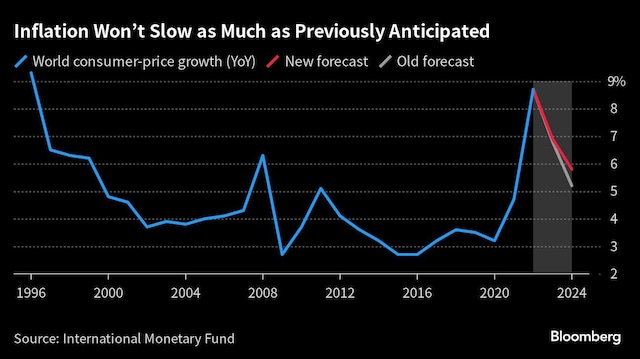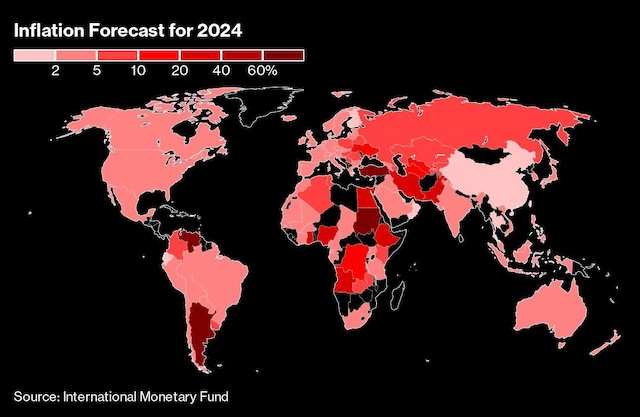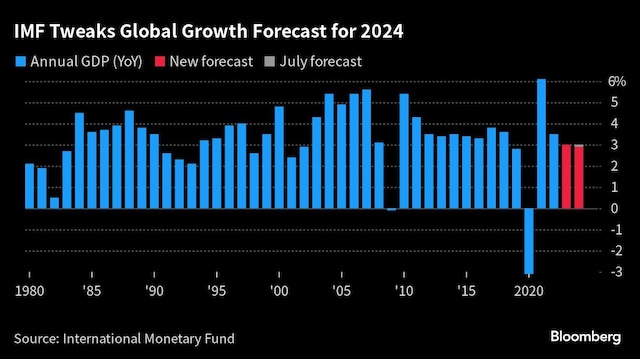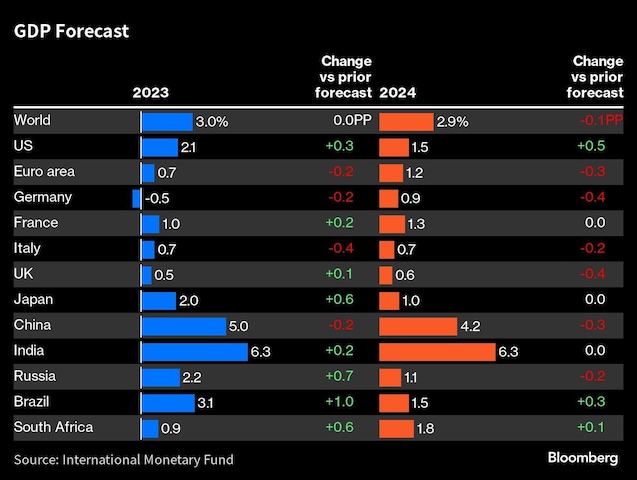IMF warns of stubborn inflation and weaker global growth in the coming year
By Eric Martin
The International Monetary Fund raised its forecast for global inflation next year and urged central banks to maintain tight policy until there is a lasting reduction in price pressures.
The IMF raised its forecast for the pace of global consumer price growth to 5.8 percent next year in its global economic outlook released on Tuesday, up from 5.2 percent seen three months ago. The call for vigilance on inflation comes as it also cut its forecast for economic growth in 2024.
In most countries, the IMF, an institution tasked with monitoring the health of the global economy, expects inflation to remain above the central bank’s targets until 2025.

The forecasts are a much-anticipated event at the annual meetings of the IMF and the World Bank, which are being held this week in Marrakesh, Morocco – the first time they have been held in Africa in 50 years. The event comes after a deadly attack on Israel by Hamas at the weekend, which shook the world and revived fears of a wider conflict in the Middle East, home to almost a third of the world’s oil supplies. The attacks represent another factor in a period marked by global uncertainty.
Central banks in major economies, including the U.S. and European Union, have raised interest rates aggressively for more than a year to curb inflation, which has reached 8.7 percent globally in 2022, the highest level since the mid-1990s. of the last century.
“Monetary policy should remain tight in most places until inflation comes down to targets in a sustained way,” Pierre-Olivier Gurinchat, the IMF’s chief economist, told reporters at a briefing. “We’re not quite there.”
Growth was driven by factors including supply chain disruptions due to the coronavirus pandemic; fiscal stimulus in response to global lockdown; subsequent strong demand and a tight US labor market; and food and energy disruptions from the Russian invasion of Ukraine, which had a particular effect in Europe and the UK.
The fund forecasts global growth of 2.9 percent next year, down 0.1 percent from its July forecast and below the 3.8 percent average over the two decades before the pandemic. Its forecast for 2023 remains unchanged at 3 percent.

Since April, the fund has warned that the medium-term outlook has weakened. Factors holding back expansion include the long-term effects of the pandemic; the invasion of Ukraine; the disintegration of the world economy into blocs; and central bank policy tightening.
“We see a global economy that is limping along and not yet in a hurry,” Gurinchas said.

Although the outlook for global growth is low, it is relatively stable and the IMF sees a better chance for central banks to tame inflation without sending the world into recession.
Yet the robustness of the IMF’s overall growth forecast masks some important changes in the forecasts for the individual countries that support it. The forecast for the U.S., the world’s largest economy, this year was raised to 2.1% from 1.8% in July, and the forecast for next year increased to 1.5% from 1%, based on more strong business investment in the second quarter and sustained consumption growth.
The IMF projects the U.S. unemployment rate will rise to a peak of 4 percent by the final quarter of 2024 — down from the 5.2 percent forecast in April, “consistent with a softer landing than previously expected for the US economy’.

On the other hand, the growth forecast for China, the world’s second largest economy, was cut to 5% from a projected 5.2% in 2023 and to 4.2% from 4.5% in 2024. China’s economy is losing momentum because of a decline in real estate investment and house prices that threaten government revenue from land sales, as well as weak consumer sentiment.
“Restoring confidence, cleaning up this sector will require decisive action by the authorities and we have seen some movement in that direction, but more is needed,” Gurinchas said. “If that doesn’t happen, then there’s a chance that this problem will deepen and get worse.”
The growth forecast for the euro area was also cut to 0.7% in 2023 from a previous estimate of 0.9% and to 1.2% in 2024 from a 1.5% forecast earlier.
There is also a divergence between European economies, with Germany contracting more than expected amid weakness in interest rate-sensitive sectors and slower demand from trading partners. However, France’s forecast was upgraded after there was a catch-up in industrial production and foreign demand outperformed in the first half of 2023.
The IMF raised Japan’s growth forecast for this year to 2 percent from a previous forecast of 1.4 percent, as it is supported by pent-up demand, a surge in tourism, accommodation policies and a recovery in car exports that were previously held back from supply chain challenges.
The UK’s growth forecast for next year was cut to 0.6 percent from 1 percent, reflecting tighter monetary policies to tame still-high inflation and the continued impact of a terms-of-trade shock from high energy prices.
The IMF has repeatedly warned of fragmentation in the global economy, or its breakup into geopolitical blocs along fault lines, due to tensions between the US and China, as well as Russian aggression.
The fund forecasts trade growth of 0.9 percent this year, down from the 2 percent expected in July and compared with an average of 4.9 percent over the two decades before the pandemic. This reflects a shift to local services, the lagged effects of an appreciating dollar that slows trade due to the widespread invoicing of products in dollars, and rising trade barriers.
